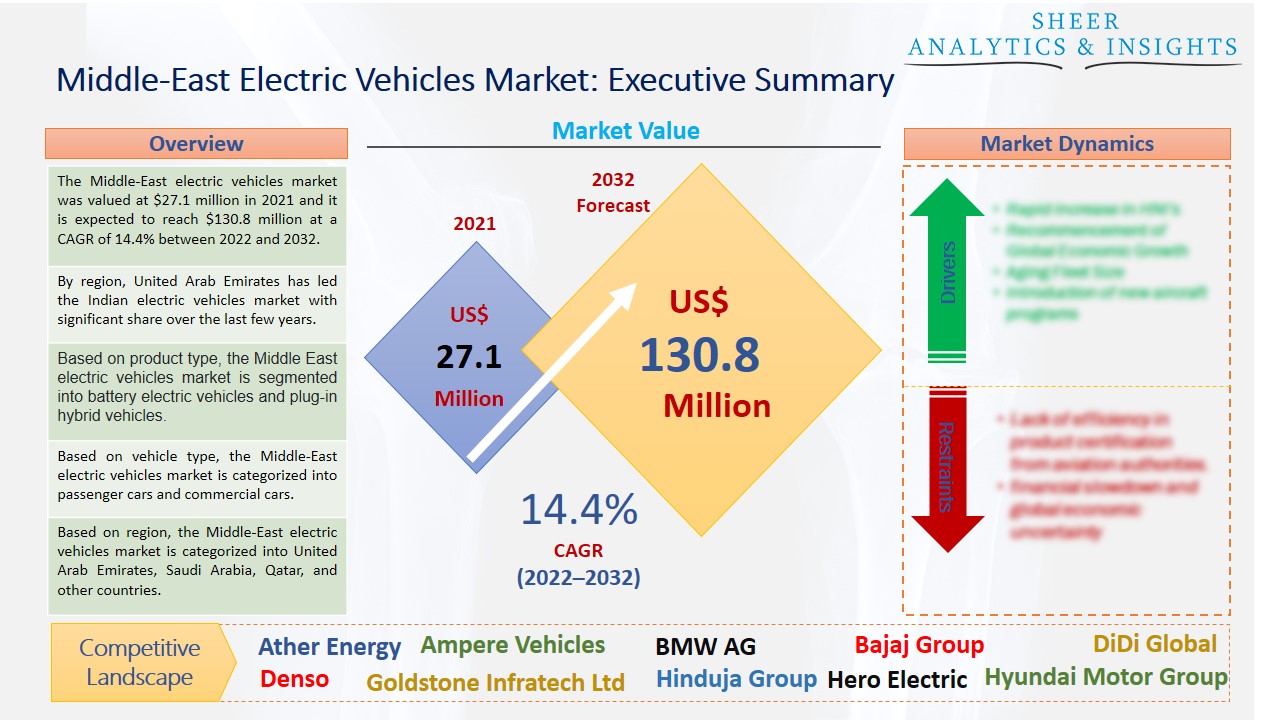Middle-East Electric Vehicles Market (By Product Type: Battery Electric Vehicles, Plug-In Hybrid Vehicles. By Vehicle Type: Passenger Cars, Commercial Cars. By Region -Middle-East) - Industry Analysis, Growth, Trends & Forecast, 2022-2032
Report Type : Syndicate Report
The Middle-East electric vehicles market was valued at $27.1 million in 2021 and it is expected to reach $130.8 million at a CAGR of 14.4% between 2022 and 2032. Due to the increasing awareness of global warming and the rise in fuel prices, the electric vehicles market is estimated to witness several growth opportunities across the Middle-East region during the forecast period.
By region, United Arab Emirates has led the Indian electric vehicles market with significant share over the last few years.
Over the past few years, the price of fuel is growing in the Middle-East countries, which is a major concern currently all the governments of the nations are facing. The government of the Middle-East region is taking preconscious and focusing on grabbing advantage of this current situation. Several manufacturing companies are focusing on producing new electric vehicles for commercial transportation as well as private transportation. Hence, it certainly makes a better case for buying electric vehicles. Complete charging of an electric vehicle costs just a tiny fraction of filling the tank with petrol. Moreover, the public and private sectors both would work together on steering policy alongside innovation. At present days, travel and tourism agencies are adopting new electric vehicles which would benefit the public while traveling at low costs. However, the price of oil has surged in the past several weeks, mainly because of the supply concerns linked to the war between Russia and Ukraine. This is another major factor that is driving the growth of the electric vehicles market during the forecast period.

Source: SAI Research
Download Free PDF Sample Request
Based on product type, the Middle East electric vehicles market is segmented into battery electric vehicles and plug-in hybrid vehicles. The battery electric vehicles segment holds the largest share of the market and is accounted for the larger share in the upcoming years. Hence, this type of vehicle operates on an electric motor instead of an internal combustion engine. In addition, this engine generates power by burning a mix of fuel and gases. Thus, the segment is anticipated to boost market growth over the upcoming years.
Based on vehicle type, the Middle-East electric vehicles market is categorized into passenger cars and commercial cars. The commercial cars segment is accounted for the largest share of the market. Due to the increasing population and growing prices of fuel, public transportation is becoming more essential for people across the region. Hence, this category is projected to accelerate the growth of the market during the forecast period. Key players are also trying to produce more innovative electric vehicles for public passengers. This would also benefit the market to gain growth opportunities.
Based on region, the Middle-East electric vehicles market is categorized into United Arab Emirates, Saudi Arabia, Qatar, and other countries. Among these, United Arab Emirates holds the maximum share of the market and is projected to gain more growth opportunities due to the rising demand for electric vehicles among a large number of people in the nations across the Middle East region. Most of the manufacturing companies are located in the United Arab Emirates. These companies are currently focusing on creating new electric vehicles so customers could get the facilities in several places. However, in some places, oil still constitutes a major source of national revenue and domestic fuel for several Middle-Eastern countries. Hence, the respective governments are trying to focus on the matter to adopt new energy sources which would create electric vehicles for the new companies. This would drive the growth of the Middle-East electric vehicles market.
According to the study, key players such as Ather Energy (India), Ampere Vehicles (India), BMW AG (Germany), Bajaj Group (India), DiDi Global (China), Denso (Japan), Greely (China), Groupe Renault (France), Goldstone Infratech Ltd (India), Hinduja Group (U.K), Hero Electric (India), Hyundai Motor Group (South Korea), JBM Auto Ltd (India), Lucid Motors (U.S), Mercedez-Benz Group (Germany), Mahindra Group (India), Ola Cabs (India), Porsche SE (Germany), Suzuki (Japan), SAIC Motor (China), Tesla Inc (U.S), Toyota (Japan), among others are leading the Middle-East electric vehicles market.
Scope of the Report:
| Report Coverage | Details |
| Market Size in 2021 | US$ 27.1 million |
| Market Volume Projection by 2032 | US$ 130.8 million |
| Forecast Period 2022 to 2032 CAGR | 14.4% |
| Base Year: | 2021 |
| Historical Data | 2019, 2020 and 2021 |
| Forecast Period | 2022 to 2032 |
| Segments covered |
By Product Type: Battery Electric Vehicles, Plug-In Hybrid Vehicles By Vehicle Type: Passenger Cars, Commercial Cars |
| Geographies covered | Middle-East Electric Vehicles Market: United Arab Emirates, Saudi Arabia, Qatar |
| Companies covered | Ather Energy (India), Ampere Vehicles (India), BMW AG (Germany), Bajaj Group (India), DiDi Global (China), Denso (Japan), Greely (China), Groupe Renault (France), Goldstone Infratech Ltd (India), Hinduja Group (U.K), Hero Electric (India), Hyundai Motor Group (South Korea), JBM Auto Ltd (India), Lucid Motors (U.S), Mercedez-Benz Group (Germany), Mahindra Group (India), Ola Cabs (India), Porsche SE (Germany), Suzuki (Japan), SAIC Motor (China), Tesla Inc (U.S), Toyota (Japan) & Others |
The Middle-East Electric Vehicles Market Has Been Segmented Into:
The Middle-East Electric Vehicles Market – by Product Type:
- Battery Electric Vehicles
- Plug-In Hybrid Vehicles
The Middle-East Electric Vehicles Market – by Vehicle Type:
- Passenger Cars
- Commercial Cars
The Middle-East Electric Vehicles Market – by Regions:
- United Arab Emirates
- Saudi Arabia
- Qatar
- Others
Buy Chapters or Sections
Customization options available to meet your custom research requirements :
- Request a part of this report
- Get geography specific report
- Request historical analysis
- Check out special discounted pricing

